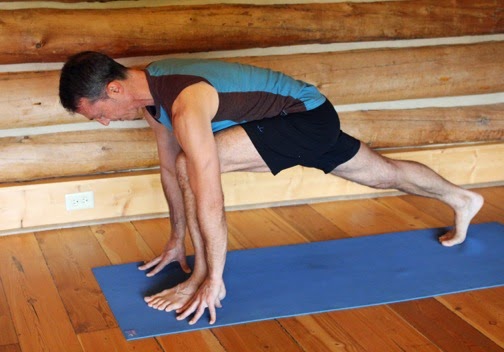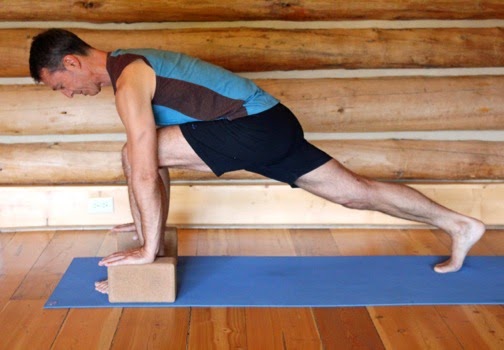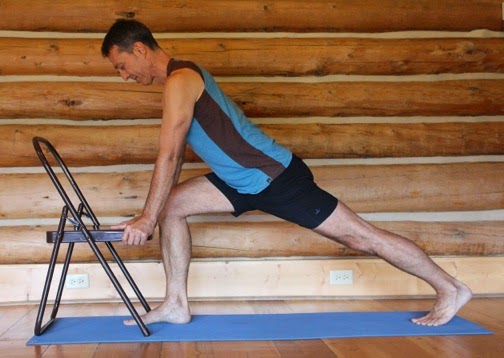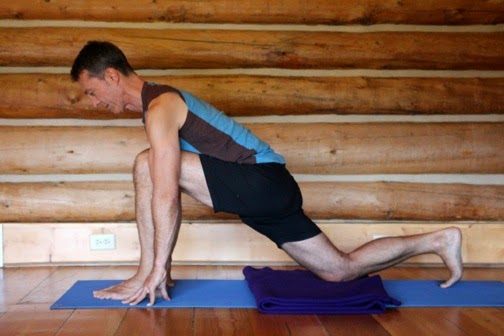by Baxter

Today I want to look at the Lunge pose (Vanarasana) and some variations to either practice a standalone pose or add into your Sun Salutations. Lunges come in different varieties (Ram described some of these in his post Exploring the Monkey Poses). Today I will talk about a basic High Lunge, two modified High Lunges and a Dropped-Knee Lunge. They all share a basic shape, but the variations can be more appropriate for some practitioners and can also have different effects on parts of the body.
In general, the High Lunge and its variations are a good way to work on two primary movements in the hip joints: deep flexion (in the front leg) and extension (in the back leg). Because the front knee is bent to a 90-degree angle, the front quadriceps, psoas, and iliacus muscles are strengthened and the front leg gluteal and hamstring muscles are lengthened. The opposite occurs in the back leg, resulting in lengthening of the rectus femoris part of the quads, as well as the psoas and iliacus muscles, while strengthening the back gluteal and hamstring muscles. The back leg calf muscles can also get a nice stretch! The spine is somewhat neutral in alignment, although the lumbar region can end up in slight flexion due to the pull of the hips into a bit of backward tilt by the position of the front leg. This is a good pose in which to learn how to lengthen the front of your body. Your arms can contribute to the stability of the pose if you press your hands more fully into the floor, blocks or chair, and therefore assist in balance and also general strengthening of your arms and upper chest region. Ideally your head and neck align with the rest of the spine.
Lunges can be a good preparation for backbends, as stretching your quads, psoas, and iliacus muscles will help open the fronts of your thighs and hips, which helps make backbends more comfortable. They can be a great segue into many of the standing poses because you can move directly into many standing poses by simply pivoting the sole of your back foot down to the floor and then move into poses such as Warrior 1 or 2 (Virabadrasana 1 and 2), Triangle pose (Trikonasana), Extended Side Angle pose (Uttitha Parsvakonasna) or Pyramid pose (Parsvottanasana).
Baxter prescribes this pose for:
- arthritis or stiffness of the hips
- tight, short psoas muscles (common for runners and cyclists)
- low back stiffness and mild low back pain situations
- general spinal lengthening awareness
- held tension in the psoas, quads, hamstrings and calves
- practitioners who sit a lot during the day, as a general body enlivener
- preparation for standing poses of all sorts, as well as backbends
- practitioners who need to work on balance (since all four limbs are in contact with floor, it challenges balance, though not dramatically)
Instructions: Start by standing in Mountain pose (Tadasana) at the front of your yoga mat. Next, come into an easy Standing Forward Bend (Uttanasana), placing your fingertips on the floor, blocks, or the front edge of a chair. As you bend your right knee, keeping your front knee positioned directly above your front ankle joint, step your left foot back far enough (3-5 feet, depending on your height and leg length) so you can straighten your left leg. Keep the ball of your foot and toes on the ground, and keep your toes pointing straight forward. If you are not using a chair, position your arms parallel with your front shinbone, pressing your fingers or hands down while simultaneously lengthening back up your arms towards your shoulders.
In basic High Lunge imagine a straight line moving from your back heel through your back leg and spine and out to the top of the head. Actively firm and fully straighten your back knee joint. Also, press down firmly into your front foot to activate the supportive muscles of the front leg without going to the point of straightening the front knee. Imagine lengthening the front surface of your body from your pubic bone to your collarbones. Stay for just a few breaths or up to one to two minutes in the full pose.

To come out, bend your back knee slightly and step forward into Standing Forward Bend (Uttanasana). Then inhale back up to Mountain pose (Tadasana). Repeat on the second side.
Version 2: In this version you use blocks to support your hands, at whichever height allows you to feel both the work in your hips and the length of your spine. Some practitioners have shorter arms and a larger chest, which can lead to more dramatic rounding the spine or a sense of claustrophobia and trouble breathing. The blocks can do wonders to balance this out.

Version 3: In this version you use a chair to support your hands. This variation can allow those with greater limitations in hip flexibility and spinal flexibility a safe opportunity to experience the benefits of the pose without overdoing it. If you wish, you can place the chair against a wall so that when you come into the pose, the chair can not slide away from you.

Version 4: In this version, you bend your back leg and drop your back knee onto the floor. In general, this provides more lengthening of the back leg quad, psoas, and iliacus muscles, making it an especially good warm up for backbends, as well as deeper stretch to the front leg gluteus and hamstring muscles.
Because the patella (kneecap) has only a thin layer of skin over the bone, most people prefer some padding under their back knee in this pose, so before coming into the pose, place a folded blanket on your mat. To come into the pose, start by going into full High Lunge pose (in any of the variations described above). Then bend your back knee and gently lower it down to the blanket. If your knee feels uncomfortable, try shifting your weight on to the upper part of the knee, rather than the mid-knee—experiment to find what works best for you. You can do this pose either with the tops of your back toes on the floor or with the toes turned under; with your toes turned under, you will get more calf stretch in you back leg.

To come out of the pose, lift your back knee off the floor and step your back foot forward into Standing Forward Bend, just as you would for High Lunge.
Cautions: Because your legs are positioned in opposite directions, there can be torque in the pelvic bones, so people with sacroiliac joint issues should be mindful to try and keep the pelvis in a neutral alignment. Anyone with hamstring or groin pulls should wait until those areas are healed before trying the pose for any significant length of time. Those who have pain when deeply bending the front knee should use blocks or a chair to diminish the compression on the knee structures. Those with osteoporosis or osteopenia should be careful entering the pose from Standing Forward Bend (Uttanasana), being sure to bend their knees more deeply and keep their spines more neutral as they transition into the Lunge position.
Follow Yoga for Healthy Aging on Facebook ° To order Yoga for Healthy Aging: A Guide to Lifelong Well-Being, go to Amazon, Shambhala, Indie Bound or your local bookstore.


Leave A Comment